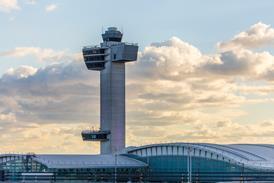Héroux-Devtek has won its third major contract with Boeing, taking over the manufacturing of the main landing gear and side braces for the Boeing F/A-18 and EA-18G Growler from United Technologies Aerospace Systems.
The Canadian company, which secured a breakthrough deal with Seattle to build the landing gear for the 777 and 777X in 2013 – also knocking out incumbent UTAS – will begin delivering the fighter’s landing gear in the third quarter of 2020.
Gilles Labbé, the president and chief executive of the Montreal-based firm, says the latest contract will deliver around C$200 million ($152 million) in revenues over 10 years, with a substantial share of that coming from the aftermarket.
Boeing has an order of at least 110 F/A-18 Super Hornets from the US Navy, and is pitching the jet to India and Canada, among others. However, with 700 of the type in service, Labbé says the aftermarket represents a significant opportunity for spares, servicing and repairs.
Boeing owns the intellectual property to the F/A-18 landing gear design – as it does with the 777 – but Labbé says Heroux-Devtek will “work closely with Boeing to exploit the aftermarket opportunity”.
Héroux-Devtek, which also builds the landing gear for the Boeing CH-47 Chinook and Saab Gripen, will deliver its first landing gear for the new 777-9 next month. It is currently producing landing gear for around 50 current-generation 777s a year, but has capacity in its assembly plant in Cambridge, Ontario to build 100 shipsets.
Labbé expects a ramp-up ahead of the 777-9’s entry into service in 2020.
He is seeking to almost double in size of Héroux-Devtek in the next five years – from around C$380 million in the last financial year to C$700 million – through acquisitions and organic growth. The company recently bought two landing gear components manufacturers, Beaver in the US and Airbus-owned CESA in Spain, giving it access to programmes such as the Airbus C296 and the Eurofighter Typhoon.
“Our strategy has been to acquire complementary product ranges, but also IP that we can continue to build on. That gives us access to the aftermarket,” says Labbé. “Not long ago, only 10% of our business came from our own IP; now it is closer to 40%, with 36% of our revenues coming from the aftermarket.”
Get all the coverage from the Farnborough air show on our dedicated event page
Source: Flight Daily News


























